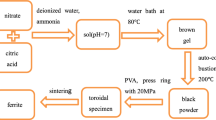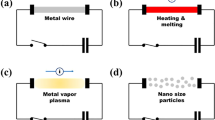Abstract
Fe–Ni nanoparticles are attractive candidates for magnetic cores of transformers and inductors that are operated at high frequencies. When applying Fe–Ni nanoparticles in magnetic cores, particle size must be controlled to enhance magnetic properties. A two-step synthetic method can be useful for fabricating size-controlled Fe–Ni nanoparticles. In the first step, Ni nanoparticles are synthesized by reducing Ni (II) acetylacetonate in oleylamine (OA) with trioctylphosphine (TOP). Thereafter, Fe (III) acetylacetonate is reduced and Fe atoms diffuse into the preformed Ni nanoparticles in OA. The size of the Fe–Ni nanoparticles depends on that of the Ni nanoparticles. However, no studies have conducted extensive investigations of their synthesis and magnetic properties with various particle sizes. Here, we attempted particle-size-controlled synthesis of Fe–Ni nanoparticles and investigated their magnetic properties. The particle size of the Fe–Ni nanoparticles was varied between 13.1. and 20.5 nm by varying the size of Ni nanoparticles. The saturation magnetization (Ms) gradually reduced with the decrease in particle size because of the increased amount of oxidized surface atoms and phosphides. Coercive forces (Hc) also decreased as the particle size decreased to 15 nm because of the increased effect of superparamagnetism, while the Hc greatly increased with the particle size reduction below 14 nm because of the ferromagnetism exhibited by the Fe layer owing to undiffused Fe atoms. Thus, using this synthetic method, Fe–Ni nanoparticles with a size of approximately 15 nm can be produced, which have a minimum Hc and are the most appropriate for magnetic cores.










Similar content being viewed by others
Data availability
The data that support the findings of this study are available from the corresponding author upon reasonable request.
References
Castrillon M, Mayoral A, Magen C, Meier JG, Marquina C, Irusta S, Santamaria J (2012) Synthesis and characterization of ultra-small magnetic FeNi/G and NiCo/G nanoparticles. Nanotechnology 23:085601. https://doi.org/10.1088/0957-4484/23/8/085601
Chen Y, She H, Luo X, Yue GH, Mi WB, Bai HL, Peng DL (2010) Chemical synthesis of monodisperse Fe-Ni nanoparticles via a diffusion-based approach. J Nanosci Nanotechnol 10:3053–3059. https://doi.org/10.1166/jnn.2010.2181
Duhamel C, Champion Y, Tence M, Walls M (2005) Synthesis of controlled-chemistry ultrafine FexNi1-x ferromagnetic powders. J Alloys Compd 393:204–210. https://doi.org/10.1016/j.jallcom.2004.10.041
Fan H, Li H (2011) High-frequency transformer isolated bidirectional DC–DC converter modules with high efficiency over wide load range for 20 kVA solid-state transformer. IEEE Trans Power Electron 26:3599–3608. https://doi.org/10.1109/TPEL.2011.2160652
Ghodke N, Kamble S, Raut S, Puranik S, Bhoraskar SV, Rayaprol S, Mathe VL (2018) Oxidation behaviour of Fe-Ni alloy nanoparticles synthesized by thermal plasma route. AIP Conf Proc 1942:050108. https://doi.org/10.1063/1.5028739
Goto Y, Taniguchi K, Omata T, Otsuka-Yao-Matsuo S, Ohashi N, Ueda S, Yoshikawa H, Yamashita Y, Oohashi H, Kobayashi K (2008) Formation of Ni3C nanocrystals by thermolysis of nickel acetylacetonate in oleylamine: CHARACTERIZATION using hard X-ray photoelectron spectroscopy. Chem Mater 20:4156–4160. https://doi.org/10.1021/cm703644x
Ibusuki T, Kojima S, Kitakami O, Shimada Y (2001) Magnetic anisotropy and behaviors of Fe nanoparticles. IEEE Trans Magn 37:2223–2225. https://doi.org/10.1109/20.951130
Ishizaki T, Yatsugi K, Akedo K (2016) Effect of particle size on the magnetic properties of Ni nanoparticles synthesized with trioctylphosphine as the cap** agent. Nanomaterials 6:172. https://doi.org/10.3390/nano6090172
Ishizaki T, Yatsugi K, Akedo K (2018) Thermal treatment to enhance saturation magnetization of superparamagnetic Ni nanoparticles while maintaining low coercive force. J Nanopart Res 20:116. https://doi.org/10.1007/s11051-018-4206-6
Karna SK, Mishra SR, Gunapala E, Dubenko I, Malagareddy V, Marasinghe GK, Ali N (2010) Synthesis and characterization of FeNi/polymer nanocomposites. J Nanosci Nanotechnol 10:5879–5884. https://doi.org/10.1166/jnn.2010.3106
Kodama D, Shinoda K, Kasuya R, Tohji K, Doi M, Balachandran J (2010) Synthesis of submicron sized Fe20Ni80 particles and their magnetic properties. J Appl Phys 107:09A320. https://doi.org/10.1063/1.3334170
Krishnan KM, Pakhomov AB, Bao Y, Blomqvist P, Chun Y, Gonzales M, Griffin K, Ji X, Roberts BK (2006) Nanomagnetism and spin electronics: materials, microstructure and novel properties. J Mater Sci 41:793–815. https://doi.org/10.1007/s10853-006-6564-1
Liu XG, Geng DY, Choi CJ, Kim JC, Zhang ZD (2009) Magnetic properties, complex permittivity and permeability of FeNi nanoparticles and FeNi/AlOx nanocapsules. J Nanopart Res 11:2097–2104. https://doi.org/10.1007/s11051-008-9575-9
Mandel K, Hutter F, Gellermann C, Sextl G (2013) Stabilisation effects of superparamagnetic nanoparticles on clustering in nanocomposite microparticles and on magnetic behavior. J Magn Magn Mater 331:269–275. https://doi.org/10.1016/j.jmmm.2012.11.053
Matsumoto T, Sadakiyo M, Ooi ML, Yamamoto T, Matsumura S, Kato K, Takeguchi T, Ozawa N, Kubo M, Yamauchi M (2015) Atomically mixed Fe-group nanoalloys: catalyst design for the selective electrooxidation of ethylene glycol to oxalic acid. Phys Chem Chem Phys 17:11359–11366. https://doi.org/10.1039/c5cp00954e
Mohamed MA, El-Maghraby AH, Abd El-Latif MM, Farag HA (2013) Optimum synthesis conditions of nanometric Fe50Ni50 alloy formed by chemical reduction in aqueous solution. Bull Mater Sci 36:845–852. https://doi.org/10.1007/s12034-013-0539-z
Mu M, Li Q, Gilham DJ, Lee FC, Ngo KDT (2014) New core loss measurement method for high-frequency magnetic materials. IEEE Trans Power Electronics 29:4374–4381. https://doi.org/10.1109/TPEL.2013.2286830
Safari S, Castellazzi A, Wheeler P (2014) Experimental and analytical performance evaluation of SiC power devices in the matrix converter. IEEE Trans Power Electron 29:2584–2596. https://doi.org/10.1109/TPEL.2013.2289746
Schaefer ZL, Weeber KM, Misra R, Schiffer P, Schaak RE (2011) Bridging hcp-Ni and Ni3C via a Ni3C1-x solid solution: tunable composition and magnetism in colloidal nickel carbide nanoparticles. Chem Mater 23:2475–2480. https://doi.org/10.1021/cm200410s
Senevirathne K, Burns AW, Bussell ME, Brock SL (2007) Synthesis and characterization of discrete nickel phosphide nanoparticles: effect of surface ligation chemistry on catalytic hydrodesulfurization of thiophene. Adv Funct Mater 17:3933–3939. https://doi.org/10.1002/adfm.200700758
Shokrollahi H, Janghorban K (2007) Soft magnetic composite materials (SMCs). J Mater Process Technol 189:1–12. https://doi.org/10.1016/j.jmatprotec.2007.02.034
Wu HQ, Qian C, Cao YJ, Cao PP, Li WT, Zhang XJ, Wei XW (2010) Synthesis and magnetic properties of size-controlled FeNi alloy nanoparticles attached on multiwalled carbon nanotubes. J Phys Chem Solids 71:290–295. https://doi.org/10.1016/j.jpcs.2009.12.079
Xu MH, Zhong W, Qi XS, Au CT, Deng Y, Du YW (2010) Highly stable Fe–Ni alloy nanoparticles encapsulated in carbon nanotubes: synthesis, structure and magnetic properties. J Alloys Compd 495:200–204. https://doi.org/10.1016/j.jallcom.2010.01.121
Yatsugi K, Ishizaki T, Akedo K, Yamauchi M (2019) Composition-controlled synthesis of solid-solution Fe–Ni nanoalloys and their application in screen-printedmagnetic films. J Nanopart Res 21:60. https://doi.org/10.1007/s11051-019-4497-2
Zhao Y, Ni C, Kruczynski D, Zhang X, **ao JQ (2004) Exchange-coupled soft magnetic FeNi−SiO2 nanocomposite. J Phys Chem B 108:3691–3693. https://doi.org/10.1021/jp037588r
Zhen L, Gong YX, Jiang JT, Shao WZ (2008) Electromagnetic properties of FeNi alloy nanoparticles prepared by hydrogen-thermal reduction method. J Appl Phys 104:034312. https://doi.org/10.1063/1.2959726
Acknowledgments
We would like to thank Editage (www.editage.com) for English language editing.
Code availability
Not applicable.
Author information
Authors and Affiliations
Contributions
All authors contributed to the study conception and design and performed material preparation, data collection, and analysis. The first draft of the manuscript was written by K.A., and K.Y. commented on previous versions of the manuscript
Corresponding author
Ethics declarations
Conflicts of interest
The authors declare no conflicts of interest.
Additional information
Deceased or incapacitated authors
T.I. passed away and Y.I., his direct relative, approved to subscribe this manuscript.
Publisher’s note
Springer Nature remains neutral with regard to jurisdictional claims in published maps and institutional affiliations.
Rights and permissions
About this article
Cite this article
Akedo, K., Ishizaki, T. & Yatsugi, K. Structural and magnetic properties of size-controlled Fe–Ni nanoparticles synthesized by diffusing Fe atoms into preformed Ni nanoparticles. J Nanopart Res 23, 107 (2021). https://doi.org/10.1007/s11051-021-05216-2
Received:
Accepted:
Published:
DOI: https://doi.org/10.1007/s11051-021-05216-2




